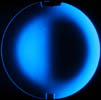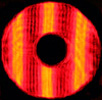Lockwood Custom Optics - Projects
Lockwood Custom Optics (LCO) has been involved in some very interesting projects, including professional research telescopes, large amateur telescopes for imaging and visual use, and other one-of-a-kind instruments for science and industry. This page summarizes many (but not all) of these projects, and shows a photo when available. Projects are ordered from the largest to the smallest aperture. Most projects are complete, but some are in progress and others are upcoming projects.LCO understands that successfully completing unique, custom projects represents broader optical experience than turning out the same mirror over and over, and this page is intended to show a diversity of projects of varying complexity and size. It also might give those who are looking for a unique or specialized telescope some ideas. Links are provided to help put them in contact with a builder/vendor who can construct it.
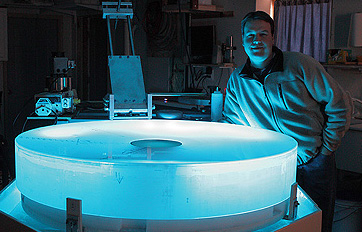 50"
f/2.2 R-C primary, 14.75" convex R-C secondary, 9.25" m.a.
flat tertiary (f/8.2 system)
50"
f/2.2 R-C primary, 14.75" convex R-C secondary, 9.25" m.a.
flat tertiary (f/8.2 system) When the 1200-lb fused silica primary mirror was received, it had been ground and was ready for polishing. After the primary was finished by LCO, the flat tertiary mirror was found to not be flat, and that was fixed. Then the secondary mirror needed some work to make it properly match the primary mirror. So, the fused silica secondary and tertiary mirrors were refigured by LCO as well. This telescope is being used for exoplanet research. The telescope became operational in mid-2013. A photo of the primary mirror during work can be seen above at right, lit by a blue rope light.
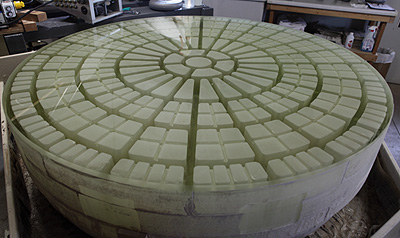 50"
f/4.0 prime-focus Newtonian
50"
f/4.0 prime-focus NewtonianThis telescope was built by Bob Holmes, founder and operator of the Astronomical Research Institute. Here is a link to Bob's official page for this telescope.
The cast cellular mirror was machined on the front, back, and parts of the sides by JPAstrocraft.com. LCO completed optical work in late 2012. Initial tests of the uncoated mirror in the telescope produced very good images with tight, round stars across the field of the CCD. The mirror was damaged during the first coating. LCO ground, polished, and figured the mirror for a second time in late 2013. Testing again confirmed an excellent figure, and a different coater successfully coated it in 2014, after which is was installed in the telescope. In its initial observing runs, the telescope reached 24th magnitude with ease, proving the quality of the optics and structure.
Just for reference, an uncoated 50" mirror easily saturates CCD cameras with a 3-second exposure on M42! Photos of the telescope with the uncoated mirror installed can be seen in this installment of "In the Shop". Photos of the official dedication of the 50" f/4.0 telescope can be seen in this installment of "In the Shop".
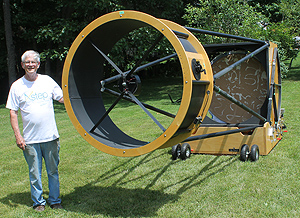 45"
f/3.75 visual Newtonian, 8" m.a. monolithic flat
45"
f/3.75 visual Newtonian, 8" m.a. monolithic flatThis telescope was built by John Pratte of JPAstrocraft.com. The client purchased the 45" BVC mirror blank (the same material as Bob Holmes' 32" f/4.0 described below) and did some work on it, but he asked LCO to finish the optical work on the primary and secondary, which are now complete.
John Pratte has finished testing the structure and it is ready for shipping. More will be posted about this exciting project as it progresses. A photo of it during testing is now included here, note that in the photo there is a cardboard cover on the mirror!
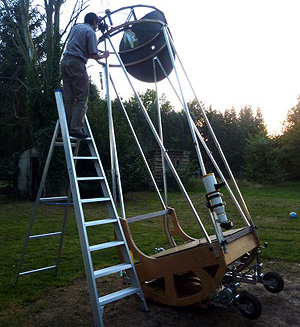 43.4"
f/3.6 visual Newtonian, 8" m.a. cast cellular flat
43.4"
f/3.6 visual Newtonian, 8" m.a. cast cellular flatThe primary mirror for this telescope was originally ordered several years ago. It was supposed to be a cast cellular blank like the 50" f/4 mentioned above. The cast cellular secondary mirror blank was received, and it was completed in 2007 and shipped to the client. After years of waiting, it became apparent that the vendor was not going to deliver the primary mirror blank. Patience had run out, but the client still wanted to finish the project.
So, at LCO's expense, a 2.3"-thick Supremax monolithic blank was ordered. The original f/3.75 focal length was shortened to f/3.6. The primary mirror was completed in April 2012. The telescope saw first light in September of 2012. Robert Houdart is the owner and telescope builder, and here is a link to his web page for the telescope. He has been exceptionally busy, but looks forward to having more time to use the telescope in the future.
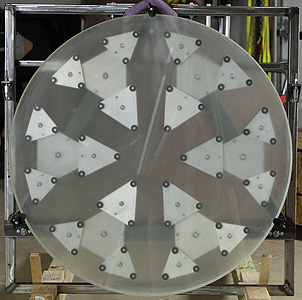 42"
f/3.75 visual Newtonian, 8" m.a. cast cellular flat
42"
f/3.75 visual Newtonian, 8" m.a. cast cellular flatThis primary has nearly the same radius of curvature as the 43.4" listed above, so it was worked right after the 43.4" because the grinding tool and pitch laps were already made with very close to the proper radius. Scheduling projects intelligently like this is one way LCO keeps efficiency high.
This mirror will go in a privately-owned telescope on the west coast. The 54-point mirror cell, showed at right with the mirror in it, was made by John Pratte of JPAstrocraft.com, and the edge support of the cell was tested with the actual mirror in it with excellent results. While at LCO, the cell was also used to test Tom Clark's 42" f/3.86 mirror mentioned below. The 42" primary was picked up by the client in early 2013. The flat was completed soon afterward. The telescope is still under construction, large telescopes take time.
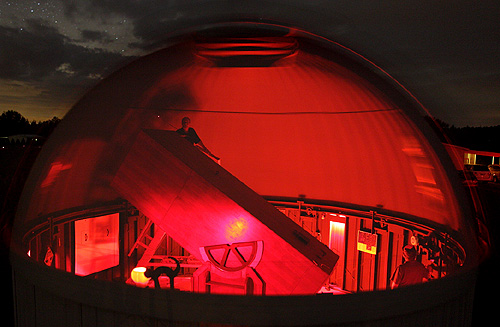 42"
f/3.86 visual Newtonian, 7" m.a. elliptical flat
42"
f/3.86 visual Newtonian, 7" m.a. elliptical flatThis telescope is owned by Tom Clark, the well known former editer/publisher of Amateur Astronomy Magazine, who recently moved from the Chiefland Astronomy Village in Chiefland, Florida, to the New Mexico Astronomy Village (Tom's page). Another NMAV page is found here. Tom has completed a new dome for the 42" at his new homestead.
Mike completed the refiguring of the primary and secondary in early 2013. He delivered and helped install them in the new observatory in April 2013. An article that Mike wrote about that trip can be found here. He says the skies are very dark and transparent when the dust is not blowing around, that he has never seen the zodiacal light so bright, and that on his his "next visit" (of which there will likely be quite a few), he may not leave!
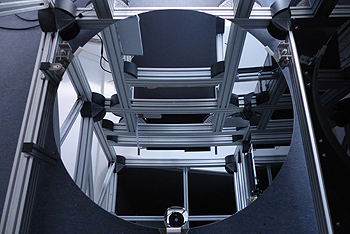 40"
f/3.0 parabolic LIDAR mirror
40"
f/3.0 parabolic LIDAR mirrorThis 2.3"-thick Supremax mirror was made for a scientific client in Germany, and was completed and shipped to the client in January of 2012.
It is performing well. These optics generally sit on their back pointing straight up into the sky collecting scattered laser light from the upper atmosphere. It is shown here in a custom-made framework that keeps it aligned properly and allows for adjustment of tilt.
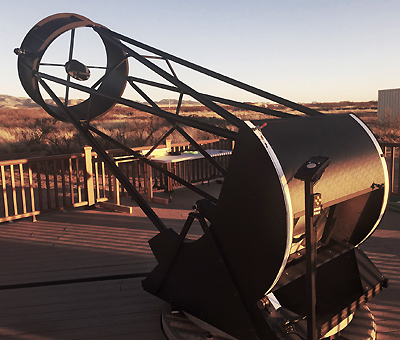 40"
f/3.75 visual Newtonian, 7.5" m.a. secondary mirror
40"
f/3.75 visual Newtonian, 7.5" m.a. secondary mirrorThis telescope features a 2.6"-thick Cervit mirror for minimal figure change with temperature. The telescope was built by StarStructure Telescopes. The instrument, pictured at left (thanks to Gary Benson for the photo), is located at a facility constructed by the Tuscon Amateur Astronomy Association. A second 40" f/3.5 instrument is being built for a private individual client.
First light for the first instrument occurred at the TAAA observing site in February of 2017, and construction of the second instrument will follow later in 2017.
Initial observing reports have been very positive, and Mike was very pleased to hear the positive feedback that started coming back as soon as the telescope was assembled. Stay tuned for more, LCO hopes to feature the telescope(s) in an article in the future. We believe that these large, high-quality instruments will be game changers in amateur astronomy.
40" f/3.5 visual Newtonian, 7.5" m.a. secondary mirror
This telescope will feature a 2.6"-thick Quartz mirror, and will be built by StarStructure Telescopes. It is for a private client, and will look quite similar to the 40" f/3.75 telescope above. Stay tuned for more updates.
40" f/13 classical Cassegrain
This optical set was reworked for the Lehigh Valley Amateur Astronomical Society. The primary and secondary are now complete and coated. More details will follow as work on the telescope structure progresses.
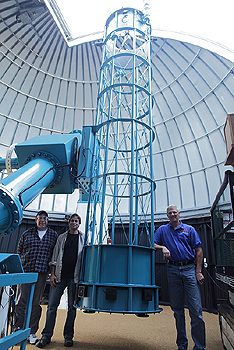 36"
f/6.3 visual Newtonian, 5" m.a. secondary mirror
36"
f/6.3 visual Newtonian, 5" m.a. secondary mirrorNo, that's not a typo - it is f/6.3, not f/3.6. This mirror replaced the primary mirror of the formerly 31" f/7 Newtonian at the Warren-Rupp Observatory near Mansfield, OH. I wrote an article about attending the Hidden Hollow Star Party in August of 2012, where I got my first views through this excellent telescope. The new mirror is thinner and cools faster. It is made from Supremax. Some photos of the mirror during work can be seen in this installment of "In the Shop".
In late 2011, the original secondary mirror assembly fell down the tube, breaking the old primary. The tube was large enough to increase the size of the primary mirror from 31" to 36", and after some discussion it was decided to increase the aperture of the instrument. John Pratte of JPAstrocraft.com made a new, improved primary mirror cell, new rotating secondary holder, and a mounting plate for a second focuser. The second focuser will make the equatorially-mounted scope usable over much more of the sky. So, overall, this work can be considered a serious upgrade of the former 31" telescope to a larger aperture and more usable 36" instrument.
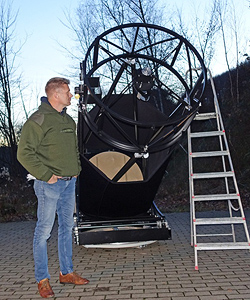 36"
f/3.3 visual Newtonian
36"
f/3.3 visual NewtonianThis primary mirror was made for a German client in 2014. The mirror is Supremax, 2.2" thick at the edge, and the figure is excellent. The secondary was acquired from another vendor, but tested by LCO and found to be of good quality. First light happened in late 2015.
The telescope was built in Germany by Ulli Vedder of Traveldob, who normally doesn't build such large instruments. It is a metal telescope with carbon-fiber truss tubes, a low profile rocker box and a drive system. Most parts are anodized aluminum, and it is a very portable instrument made to transport to local and remote observing locations in Germany, Austria and beyond. Mike had hoped to use this fine instrument when he visited Germany in the summer of 2015, but it was not ready yet. It was completed in the winter of 2015 and is ready for use under dark skies found in the mountains of Europe. Mike looks forward to enjoying the views (and trying not to freeze) on a high mountaintop in an undisclosed country.
 36"
f/3.3 parabolic LIDAR mirror
36"
f/3.3 parabolic LIDAR mirrorThis mirror was made for a scientific client, and was completed in November of 2010. It is currently in northern Norway being used for LIDAR research, and it is shown in the photo at left. In most cases, LIDAR mirrors are used to collect laser light. A laser is fired into the upper atmosphere, and a tiny amount of it is scattered and returns to the mirror. The mirror then focuses the light into a fiber optic, and it is analyzed.
While LIDAR mirrors usually don't need to be as accurate as a telescope mirror, they are generally faster (have a lower f/#) than a telescope and are usually fairly large, making them difficult to fabricate. The large collection area allows the instrument to collect enough light from the atmosphere to allow analysis, and the low f/# keeps the instrument compact.
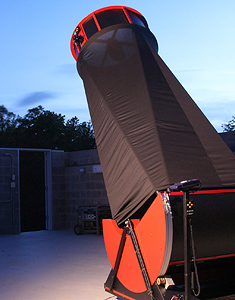 34"
f/3.6 visual Newtonian, 7" m.a. secondary mirror
34"
f/3.6 visual Newtonian, 7" m.a. secondary mirrorYes, the size is correct - this is a 34" scope for an observatory complex called the Bare Dark Sky Observatory. The facility was constructed by Mayland Community College in the Blue Ridge Mountains in Yancey County, North Carolina. It is currently the largest telescope in that region.
The site of the observatory, the Mayland Earth to Sky Park has been designated an International Dark-Sky Association star park (link to IDA listing).
The telescope was be built by Starstructure Telescopes. Starstructure builds superb metal instruments that are extremely stable in just about any environment, from humid observatories to dry mountain tops. This instrument is an observatory-class alt-azimuth telescope, of the Horizon design. The primary mirror is 2.5"-thick Supremax. The facility had its grand opening in June of 2017.
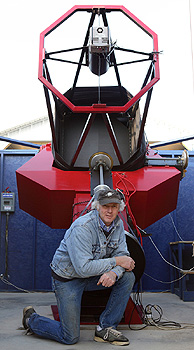 32" f/4.0
prime-focus Newtonian
32" f/4.0
prime-focus NewtonianThis fork-mounted telescope was built and is operated by Bob Holmes of the Astronomical Research Institute. This telescope has taken tens of thousands of images of asteroids and near-Earth objects (NEOs) over the last six years.
Here is a link to the official page for this telescope.
LCO completed the BVC primary mirror in June of 2006, after another optician had the mirror for 18 months and returned it to Bob with many waves of astigmatism and a large number of scratches on the polished surface.
After the completion and testing, Bob began to collect valuable scientific data with this instrument in the hopes of receiving funding to do the work. The results were indeed so good that Bob received NASA funding to do asteroid/NEO follow-up measurements to help refine the calculated orbits of potentially hazardous objects. Bob then expanded his stable of instruments - his 24" f/4.5 and 30" f/3.0 instruments are detailed below, and his 50" f/4 is described above.
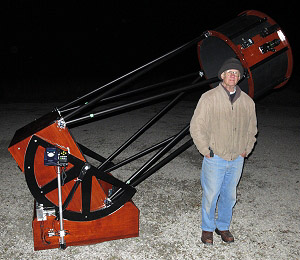 32"
f/3.6 visual Newtonian, 6" m.a. secondary
32"
f/3.6 visual Newtonian, 6" m.a. secondaryThis telescope was built by John Pratte of JPAstrocraft.com. It was completed in early 2014. It features an extremely solid offset spider of John's design, John's unique, convenient, and solid truss pole system, a state-of-the-art welded steel mirror cell with whiffletree edge support, suspended front boundary layer fan for the primary, Starlight SIPS system, and Servocat/Argo Navis drive system. It is truly a beautiful telescope, built to the highest standards, and owner Kirk Collins is very pleased with it.
Whoever says big, fast telescopes can't produce sharp images has not observed with this telescope or a properly set-up telescope using quality optics from LCO. Try one and see the difference.
 32"
f/3.6 visual Newtonian, 6" m.a. secondary
32"
f/3.6 visual Newtonian, 6" m.a. secondaryThis beautiful, all-metal telescope was built by John Novak, and has been modified a bit by the new owner to better suit his observing needs, including optics from LCO. This telescope is frequently enjoyed under warm, steady Florida skies, and is housed in a roll-off building. The deck around the telescope raises the viewing position, shortening the required ladder and keeping observers' feet out of wet grass and sand. This arrangement may also somewhat reduce the effects of ground seeing.
A friend of the owner, who had basically given up visual observing some time ago had comments to share - he said he had always thought of large Newtonians as "light buckets" and had never seen a large Newtonian perform like this one with LCO mirrors. He also commented that with views like what we were seeing, he could easily become a visual observer again and was amazed at the detail on the Moon that could be resolved.
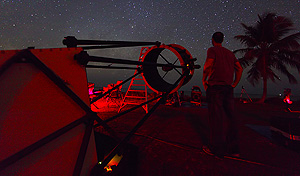 32"
f/3.6 visual Newtonian, 6" m.a. secondary
32"
f/3.6 visual Newtonian, 6" m.a. secondaryThis telescope, has traveled many miles in its fairly short lifetime, making multiple trips to Cherry Springs, the Okie-Tex Star Party, and the Winter Star Party, where it is pictured at right on the "berm". The first time it went to WSP, it was a revelation to its owner and to LCO owner/founder Mike Lockwood.
With Lockwood Optics, it has delivered amazing view at powers up to 2400x under the steady skies of the Florida Keys, and Mike credits this telescope with his best views ever of Mars, Jupiter, and Saturn, also from the Florida Keys. It now features front and rear fans on the primary mirror, which aid greatly in the fast, even cooling of the large mirror. This telescope has proven to its owner, Mike, and countless WSP and Okie-Tex Star Party attendees that large, fast telescopes with good optics produce some of the finest images of planets and deep-sky objects ever seen by amateur astronomers. The fun is really just beginning as these types of telescopes become more common!
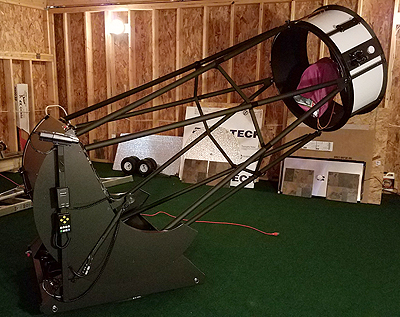 32"
f/3.3 visual Newtonian, 6.5" m.a. secondary
32"
f/3.3 visual Newtonian, 6.5" m.a. secondaryThis telescope was built by StarStructure Telescopes, and was delivered and completed in early 2016. The primary is Supremax. This telescope is in a large roll-off observatory in a very scenic location in the mountains of the eastern US.
While the weather has not cooperated completely in its first season, the owner has had a few good nights to enjoy the instrument, and has had a good time with it so far. He plans to take it to a star party in the future.
There will be many fascinating objects to investigate visually and electronically with such a superb instrument.
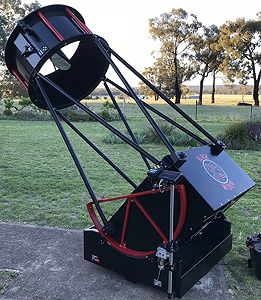 32"
f/3.3 visual Newtonian, 6.5" m.a. secondary
32"
f/3.3 visual Newtonian, 6.5" m.a. secondaryThis telescope was built by SDM Telescopes, and was completed in November of 2017. (Update: LCO visited this telescope in early 2019, see link here: LCO Visits AU). First light was memorably under the dark skies of the interior of Australia with many southern objects glimpsed. After the night of first light, the owner said:
"NGC 104 here we come. It's funny, having spent over 30 years observing on and off, that I would have a session where every time I went to a new object, it was my life time best view of it. As it was with 47 Tucanae, one of my favourite objects in the sky. It was an explosion of bright, colourful stars everywhere. We could drill right down into the core and see masses of resolved stars, it was amazing, and an appropriate way to kick the Black Widow into life. Over the following six hours we panned around looking at the show pieces of the sky, but spent most of the time further tuning the dob. NGC 2070, the Tarantula Nebula was one of the highlights. With the extra aperture, it looks every bit as detailed as an astro image and more. We came back to M42 several times, because we couldn't get enough of it. What I enjoyed most was the colour, and how it changed from green at the centre to rust and pink as we panned toward the outer sections."
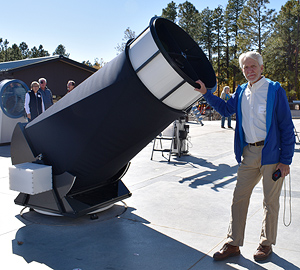 32"
f/3.0 visual Newtonian, 7.5" m.a. secondary,
32"
f/3.0 visual Newtonian, 7.5" m.a. secondary,Lowell Observatory, Flagstaff, AZ
This observatory-class Horizon telescope was built by StarStructure Telescopes for Lowell Observatory in Flagstaff, AZ. It is used for public observing nights, and has all-quartz optics to enhance performance in its high-altitude location. It was officially opened for use in early October of 2019. It resides under a large roll-off structure that houses several other telescopes.
Initial observing reports are very positive, and LCO hopes to visit on a future trip to New Mexico. It is currently the largest telescope at Lowell Observatory. Thanks to Jim, in the photo at right, for sending the photo to LCO.
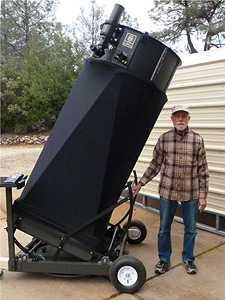 32"
f/2.8 visual Newtonian, 8" m.a. cast cellular secondary
32"
f/2.8 visual Newtonian, 8" m.a. cast cellular secondaryThis SpicaEyes telescope was built by Tom Osypowski of Equatorial Platforms. It was completed in late 2014. An 8" minor-axis cast cellular secondary was chosen to save weight and to allow fast cooling of what otherwise would have been a large, warm piece of glass smack in the middle of the light path.
Tom was very impressed with its performance on the night of first light, but he did not exptect to be! He was so surprised that he wrote a nice short article about this instrument: 32" f/2.8 first light
LCO is eager to hear the owner's impressions on this remarkable instrument as soon as he takes delivery. This is the largest f/2.8 mirror that LCO has made to date for a visual instrument, but we suspect that may change in the future. This instrument shows what LCO has known for years - collimation is not a problem at f/2.8, and fast mirrors can indeed be excellent performers.
32" f/2.35 parabolic LIDAR mirrors (three)
These mirrors were made for a scientific client in Colorado, and are being used for LIDAR research on Antarctica. They are 2.2" thick, made from Supermax. Two were completed in 2011. A third, identical mirror was delivered in early 2013.
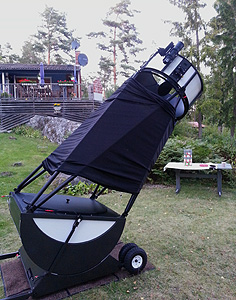 30"
f/3.6 visual Newtonian, 6" m.a. secondary
30"
f/3.6 visual Newtonian, 6" m.a. secondaryThis is the first large-aperture Horizon telescope, built by Starstructure Telescopes. This is an innovative design with truss poles of different lengths, so they only go together one way, which means very little collimation adjustment is needed. The mirror box has a rounded back and "tilted" top. This makes for a more compact, easier to transport mirror box that is space and material efficient, typically 5"-7" narrower than similar aperture telescopes. The bearings are actually the side of the mirror box, and this helps make the structure stronger. The rocker is very low profile, and the rounded back allows easier access to the things that are in there, such as the drives, electronics etc.
You probably won't be seeing this scope any time soon though - it is in Sweden, where its very happy owner enjoys viewing with it on the longer nights from fall to spring. Summer nights there are quite short, and not completely dark, so it will get more use in other seasons.
 30"
f/3.6 visual Newtonian, 6" m.a. secondary
30"
f/3.6 visual Newtonian, 6" m.a. secondaryThis mirror and secondary were made for a French client and were completed in 2016. The telescope builder, Frédéric Gea, of Stellarzac in France, and the client, Alain, were very pleased with the optics. Better images of the telescope can be seen in this blog entry by Frédéric.
I visited the owner of this telescope in 2015, and I look forward to returning to central France to see what this instrument can do some day in the future, hopefully along with the 28" f/3.5 shown below.....
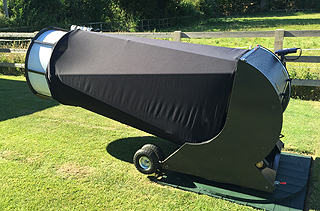 30"
f/3.5 visual Newtonian, 6" m.a. secondary
30"
f/3.5 visual Newtonian, 6" m.a. secondaryThis is a large-aperture Horizon telescope, built by Starstructure Telescopes for an English client, whom I visited in 2015. The client has had fun doing planetary and other observing from his fairly northerly latitude, as well as some imaging using video cameras. Some of his comments were:
"What was really amazing was how *round* my stars were. I couldn’t see any evidence whatsoever of astigmatism or cooling down issues after about one hour of bringing the scope outside. The combination of your optics and Mike Z's scope design all appear to be faultless. I’m VERY HAPPY INDEED - who said large f/3.5 optics aren’t great for planets!"
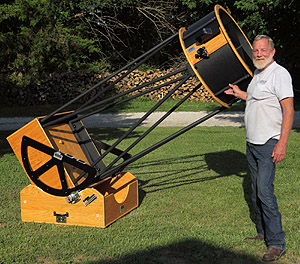 30"
f/3.3 visual Newtonian, 6" m.a. secondary
30"
f/3.3 visual Newtonian, 6" m.a. secondaryA number of these have been made for Starmaster Portable Telescopes over the years, and all have very happy owners.
The image at left shows just how manageable the size of a scope of this focal ratio is, even at 30" of aperture. Owners have reported people walking up to them and asking if it's a 24" telescope, just based on the size. When those people are told it's a 30" f/3.3, people are shocked!
A six-foot ladder is tall enough to use the scope over the entire sky unless small children want to view at the zenith. F/3.3 has become LCO's most popular focal ratio in recent years.
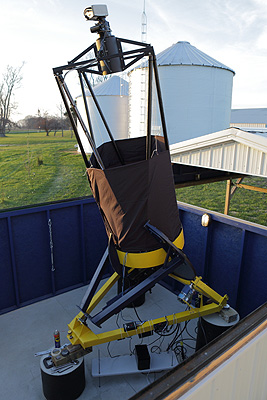 30"
f/3.0
prime-focus
Newtonian
30"
f/3.0
prime-focus
NewtonianThis telescope was built and is operated by Bob Holmes of the Astronomical Research Institute. The new mirror replaces the previous defective Cassegrain optics and the shorter focal length results in a much wider field of view. A new optical tube assembly (OTA) and mirror cell were built by Bop to hold the new 2"-thick, Supremax mirror. The rest of the mount and drive system (which was re-done when Bob first received the telescope) will be re-used.
The mirror was completed in November 2012, and became operational in mid-November. After only a the first few nights of operation it had already recovered several NEOs that had not been observed for some time (thus the term recovery). The wider field of view made this much easier, and Bob's telescope building expertise resulted in an instrument that worked extremely well right "out of the shop".
The instrument is prime-focus, with a camera placed at the upper end of the tube at the focal plane, seen in the photo at right. A Paracorr 2 is employed for coma correction. More information and photos are given in this installment of "In the Shop".
Short instruments like this are well suited for Bob's relatively windy location in central Illinois. Bob has done more NEO measures than just about anyone else in the world, all from a corn field in Illinois at an elevation of a mere ~750 feet above sea level. Many people can't believe it, but it shows what dedication and good optics can do.
30" f/3.0 visual Newtonians (four and counting)
These telescopes were built by StarStructure Telescopes for the Oil Region Astronomical Society, Oklahoma City Astronomy Club, and for a private client. This telescope is a standard offering from StarStructure and LCO, please contact StarStructure for structure information and LCO for an optics quote.
30" f/3.0 visual Newtonian
This telescope will be built by a private client. If he ever finishes it. He purchased a 20" f/3.0 and 13" f/3.0 too, and he has completed his workshop and the 13" f/3.0 telescope as of late 2019. I put this here to see if he notices.
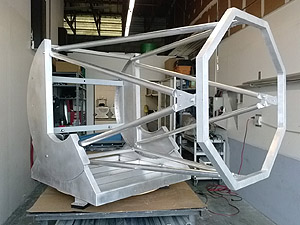 30"
f/2.0
parabolic LIDAR
mirror
30"
f/2.0
parabolic LIDAR
mirrorThis LIDAR mirror made from Supremax glass was completed in mid-2013. It will be used by a foreign university for LIDAR research.
LIDAR involves the collection of laser light after it is fired into the atmosphere. A small percentage of the scattered light is collected by the telescope and focused into a fiber optic, which routes it to various instruments for analysis.
The aluminum structure seen at right, was built by StarStructure Telescopes, manufacturer of superb all-metal telescopes.
29" f/3.1 visual Newtonian, quartz primary
This mirror was completed for a French client in late 2017. He had the following to say about his first night of observing with it: "Views are incredibly sharp, seeing was cooperative and airy disk with portion of arc were visible most of time. No astigmatism, and pinpoint stars with no diffusion all around. So very happy of this set up with very fine optics."
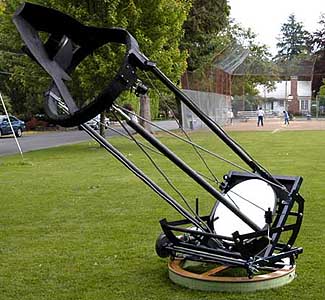 28"
f/4.5 primary, 8" round flat
28"
f/4.5 primary, 8" round flatThis mirror is used by Dan Gray in his 28" string telescope, shown at left. LCO refigured the previously astigmatic mirror and a fairly thin 8" diameter flat that is used as a secondary in this interesting design. Here's a bit from my customer comments page:
"Testing out the mirror was a success, but I needed to spend a bit more time than I had. I did find that I could find NO astigmatism, Zero! I also am now really appreciative of the tight stars, even at 358 power! .... Eric found NGC5584, so we could have a look at the super nova. It was clearly visible......Then we looked at M3, then M4, both at 358 power. Tight star images, and M4 was really cool, 'cuz of it's trails of stars and empty space. We had a look at M57, but twilight was starting to interfere. We ended on Jupiter. It was fairly low, so we went down to 246 power. When I first looked I gasped, I've never seen this much detail in the clouds. Eric made the statement 'This is the best view of Jupiter I've ever seen'."
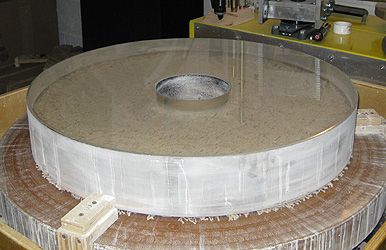 28"
f/4.0 quartz Cassegrain primary
28"
f/4.0 quartz Cassegrain primaryThis massive, full-thickness, quartz mirror was completed in 2008. LCO is unsure if it ever made it into its intended home, some type of classical Cassegrain telescope.
One thing's for sure - it's heavy!
Thankfully lifting and moving such heavy pieces of glass is something that I have lots of experience with, and something that LCO does on a daily basis.
28" f/3.66 visual Newtonian, 5.5" m.a. flat
This telescope was built by StarStructure telescopes. Optics were refigured by LCO.
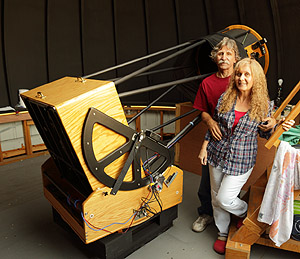 28"
f/3.5 visual Newtonian, 5.5" m.a. flat
28"
f/3.5 visual Newtonian, 5.5" m.a. flatThis telescope lives in a beautiful dome in Florida, under steady, fairly dark skies. It was built by Starmaster Portable Telescopes, and was customized to a focal ratio that was specified by the original buyer. After a couple of previous owners, it ended up here.
On a good night, with some dome ventilation, powers of 500x-800x are commonly used under the steady air that flows off the ocean, which is only 15 miles away. Powers of up to 2000x have been used.
Mike Lockwood enjoys visiting the owners during the cold winter months and observing Orion in a light jacket or sweatshirt.
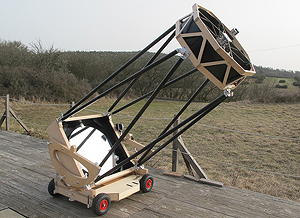 28"
f/3.5 visual Newtonian, 5.5" m.a. flat
28"
f/3.5 visual Newtonian, 5.5" m.a. flatThis telescope was built by Frédéric Gea, of Stellarzac in France, for Stéphane, a Swiss client that I visited in 2015. The structure was completed in early 2017, and produced superb images that impressed Mr. Gea on the first night that it was under the sky. He used powers of up to 1000x under the skies of southern France, viewing deep sky objects and Jupiter.
Mike looks forward to visiting Stéphane again some day and observing in the Swiss alps with this superb instrument.
28" f/3.3 cast cellular primary, 9" minor axis cast cellular secondary
This telescope is being built by a private client for imaging use. The primary mirror was completed in 2011, and the secondary in 2012.
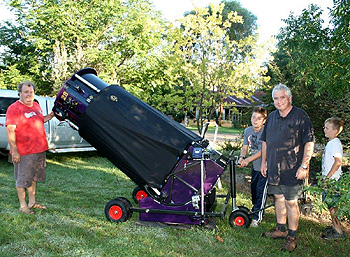 28"
f/3.3 primary, 6" minor axis elliptical flat
28"
f/3.3 primary, 6" minor axis elliptical flatThis telescope was built by Peter Read of SDM Telescopes in Australia and completed in early 2013. Here's a photo of it with its new owner and Peter (at right). Looks like the kids are eager to help take the wheels off so they can get to observing.
Nicknamed "Wild Thing", its purple color make it stand out from the crowd, even though it's not tremendously tall.
Peter's page about the telescope with lots more pictures can be found here.
28" f/3.3 primary, 6" minor axis elliptical flat (two)
No this is not a typo - two more 28" f/3.3s will be built by Peter Read of SDM Telescopes in Australia. More on them as they are completed in 2016.
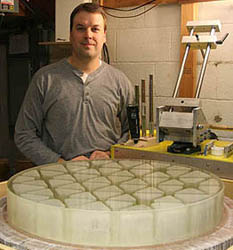 28"
f/3.1 prime-focus corrected Newtonian telescope (three)
28"
f/3.1 prime-focus corrected Newtonian telescope (three)Three of these telescopes were built by Astroworks Corporation for prime focus-imaging use.
LCO completed the optical work on the three primary mirrors, which are of cast cellular construction and feature hyperbolic figures to go with custom correctors.
LCO was the fourth company to work on these mirrors. At right Mike Lockwood is shown with one of the three mirrors on the machine while it was being worked. Before work it was necessary to machine the back surface flat so that the mirrors could be supported uniformly.
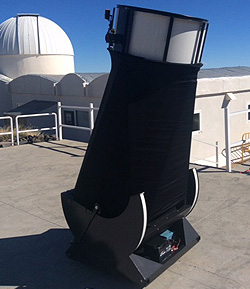 28"
f/3.0
visual Newtonian, 6.5" m.a. secondary mirror
28"
f/3.0
visual Newtonian, 6.5" m.a. secondary mirrorThis telescope was built in 2015 by StarStructure Telescopes, and is of the Horizon design. Here are the owner's first experiences in his own words, high on a mountain on an island in the east Atlantic:
"First of all your optics are top notch! Thanks a lot for telling me to go for Mike Z. Starstructure, we are delighted of the combination. (I was at first a bit skeptical about the whole package in terms of rigidity and repeatability of collimation.)
Its not unusual to have seeing under 1" over here and we already pushed the beast to 600X with no problem. We are working on a fan/a/c cooling system for faster temperature adaptation as the scope will be outside on a fixed platform.
Images on Moon and jupiter have been really astounding! The telescope is still under test but on the whole all, is VERY POSITIVE!" - Eric
28" f/2.8 visual Newtonian, 6.5" m.a. secondary mirror
This telescope was built in 2015 by StarStructure Telescopes, and is of the Horizon design. More details will follow, we hope.
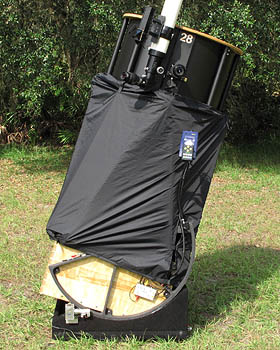 28"
f/2.75
visual Newtonian, 7" m.a. secondary mirror
28"
f/2.75
visual Newtonian, 7" m.a. secondary mirrorThis telescope was built by Webster Telescopes for a private client in Florida. At f/2.75, it is one of the fastest visual instruments in the world, but the client's experiences indicate that it performs exceptionally well compared to similarly-sized telescopes with much taller ladders.
The client is extremely pleased with the performance of this ultra-fast instrument, and routinely uses it at high power under steady Florida skies. It requires no ladder, and only a short step is needed to reach the focuser (a SIPS focuser/Paracorr 2 unit) at zenith. With superb optics and a compact structure, this extremely versatile instrument shows what large, fast instruments can and will do in the present and in the future.
F/2.75 is LCO's recommended threshold for visual telescopes. Faster mirrors can be made, but they are not recommended at this time unless the application is different than high-quality visual observing. Mike feels that below f/2.7 obtaining superb images becomes more difficult.
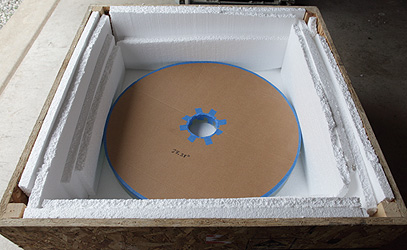 28.4"
f/2.66
hyperbolic
primary, ~10.5" m.a. flat or ~8" diameter Cass. secondary
28.4"
f/2.66
hyperbolic
primary, ~10.5" m.a. flat or ~8" diameter Cass. secondaryThis telescope is being built by a French client for imaging use. A custom corrector will allow imaging and visual use utilizing the hyperbolic primary mirror. The primary mirror was completed in September of 2012. The primary will either be used with a flat secondary mirror and custom corrector. The 10.6" m.a. flat secondary mirror, using a cast cellular blank is complete and the set is pending coating. The client has been designing a corrector for quite some time, and has been in no hurry to receive the optics.
28" f/2.4 parabolic LIDAR mirror
This mirror was complete in early 2016 for a German scientific client.
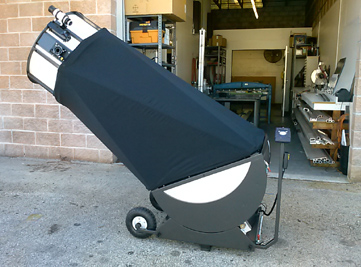 26"
f/3.3 visual Newt., 5.5" m.a. sec. mirror
26"
f/3.3 visual Newt., 5.5" m.a. sec. mirrorThis telescope is being built by StarStructure Telescopes for an international client. The optics were completed in early 2013, and the scope soon afterward. This is the first instrument built with new Horizon design, one of the most interesting and innovative designs to come around in some time. The whole rocker box is curved around the same countour as the outside radius of the altitude bearing. No doubt we'll be seeing more of them in the future.
Mike Zammit, owner of StarStructure, says that the design works extremely well for large instruments, so hopefully we'll see some 36" f/3 and 40" f/3 Horizon StarStructures taking shape in the future with optics from LCO. Ask Mike Z. for details about this innovative telescope.
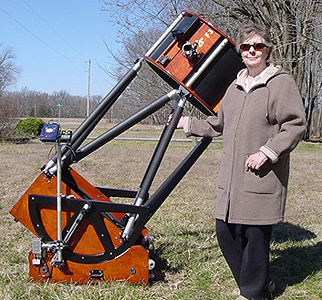 25"
f/3.0 visual Newtonian, 6.0" m.a. secondary mirror
25"
f/3.0 visual Newtonian, 6.0" m.a. secondary mirrorThis custom telescope was built by John Pratte of JPAstrocraft.com, for a private client in North Carolina. The mirror is 1.75"-thick Pyrex. The cell is a state-of-the-art design validated by JPAstrocraft and Lockwood Custom Optics.
It can also be seen in this JPAstrocraft web page, which shows the scope in the second photo from the top, and other construction details of the 25" instruments built by John Pratte. It also features a custom-made mirror cell designed by John and tested in the LCO shop.
These telescopes are extremely solid, and hold collimation superbly. They are built to the highest mechanical standards.
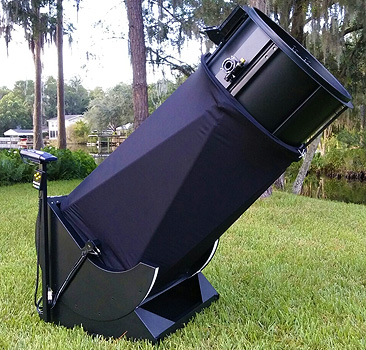 25"
f/3.0 visual Newtonian, 6.0" m.a. secondary mirror
25"
f/3.0 visual Newtonian, 6.0" m.a. secondary mirrorTwo of these Horizon telescopes are being built by StarStructure Telescopes. The one pictured here is complete, and features a variety of features from front and rear mirror cooling fans, to metal construction, powder coating instead of paint on many parts, and even remote collimation controls on one of them. These telescopes hold collimation like a dream, and feature some of the most advanced designs available in an alt-azimuth telescope.
The second telescope is under construction and is still available to a lucky future owner. Contact StarStructure and Lockwood Custom Optics if you are interested in an amazing instrument that keeps your feet on the ground and doesn't sacrifice performance.
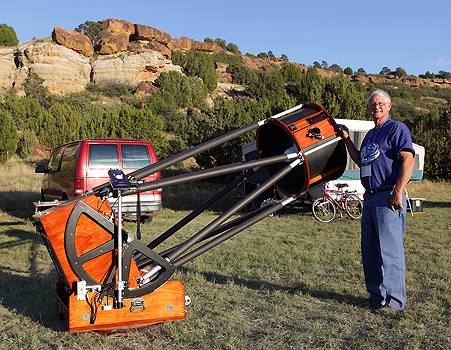 25"
f/4.0 visual Newtonian, 4.5" m.a. secondary mirror
25"
f/4.0 visual Newtonian, 4.5" m.a. secondary mirrorVery similar to the telescope above (almost identical, in fact), this telescope is simply longer than the f/3.0 version. Also built by John Pratte of JPAstrocraft.com, it features the same extensively-tested mirror cell.
The picture at right shows it at the Okie-Tex Star Party, and it has also ventured to the Winter Star Party a few times.
The photos don't really do it justice, you have to see it for yourself to see all of the details that make it outstanding. John has these available for sale, and may even have one in stock. Here is the web page for John's 25" scopes.
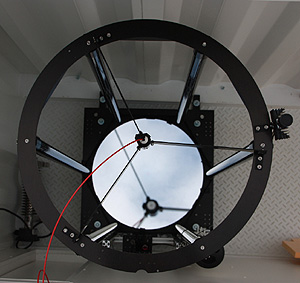 25"
f/2.4 LIDAR mirror
25"
f/2.4 LIDAR mirrorThis parabolic mirror was completed in early 2014 for a European research agency. LIDAR mirrors are normally large, fairly fast mirrors (with low f/#s) so that the telescope/instrument can collect lots of light and be fit in relatively compact spaces.
This mirror is currently being used for LIDAR research in New Zealand. The photo shows the mirror below with the optical fiber (red curved item) positioned above it at the focus. The mirror receives faint returns from a laser fired into the upper atomosphers, and the mirror collects the light into the optical fiber. The fiber takes the collected light off to be analyzed.
This is one of many LIDAR optics that LCO has produced.
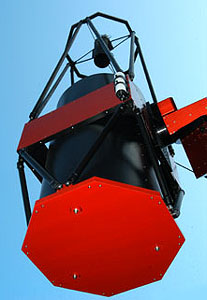 24"
f/4.5 prime-focus Newtonian
24"
f/4.5 prime-focus NewtonianThis telescope was built and is operated by Bob Holmes of the Astronomical Research Institute. It features aluminum construction with carbon fiber tubes. The mirror is 1.6" thick Pyrex.
Despite its relatively large aperture, it is lightweight (143 lbs.) and is comfortably carried by a Paramount ME.
Every year it is used to take thousands of high quality scientific images that determine the positions of asteroids in order to help refine their orbits. It produces extremely sharp images that allow it to image fainter objects than many larger scopes. Not doubt the fairly thin mirror's fast cooling also boosts performance.
Here is Bob's official page for this instrument.
 24"
f/4.4 conical mirror for Newtonian
telescope
24"
f/4.4 conical mirror for Newtonian
telescopeThis mirror had major overcorrection when tested initially. The owner, who was involved with the Okie-Tex Star Party, had been disappointed with its performance for many years, but had not had it tested.
After taking delivery of it at a star party, it was refigured, and the owner is now extremely pleased with its performance. The photo at right shows Mike Lockwood posing with the mirror while wearing one of his Okie-Tex T-shirts depicting the bolide that lit up the star party several years ago, and which Mike saw through his eyelids while trying to go to sleep!
Large conical mirrors represent a challenge to support during work and testing, but LCO is up to the challenge of these, and other unique substrates.
24" f/4.0 corrected Dall-Kirkham primary, 10" diameter convex secondary
The optics for this telescope were completed in early 2012. The builder/designer designed a custom corrector for the system.
 24"
f/3.3 visual Newtonian
24"
f/3.3 visual NewtonianIn recent years, a 24" f/3.3 mirror and 5.5" m.a. flat secondary has been LCO's most popular optical set. The sets feature a primary mirror that is 1.5"-1.6" thick for light weight and fast cooling. LCO has made them for a variety of manufacturers, including Starmaster and StarStructure.
The image at right shows a 24" f/3.3 StarStructure Horizon telescope and its owner, Doug, in northern Michigan. He's very pleased with the tight star images and detailed planetary images.
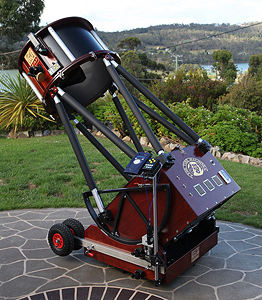 24"
f/3.3 visual Newtonian
24"
f/3.3 visual NewtonianThis 24" f/3.3 was built by SDM Telescopes in Australia. Your can read much more about it here. The client says:
"Peter delivered the superb new SDM 24" f3.3 to our home in Tasmania recently, it is a beautiful work of art if I may say. First light was in average conditions and only lasted from twilight and an hour of total darkness, however did reveal some of the optics' potential. Our first alignment star was Sirius and in almost daylight conditions 'Sirius B' was clearly visible. M42 clearly showed blue and magenta hints in the massive amount of detail, although the cloud has been relentless this summer we are able sneak the odd glimpse and treated to some magic views as new objects find their way into the EP. We did have a chance to look at Jupiter last night and test the optics with our neighbours, the GRS was in transit and gave the appearance of an egg yolk in 3D again under average seeing, Io was almost occulted and was clearly disk shaped. We are fortunate to live in a dark sky location where the milky way is bright and clear, I am sure this mirror will continue to amaze us for years to come. Thank you for your dedication to your craft and your excellent optics."
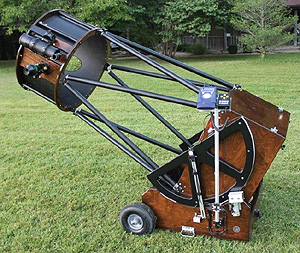 24"
f/3.3 visual Newtonian
24"
f/3.3 visual NewtonianThis version of the 24" f/3.3 telescope was built by John Pratte of JPAstrocraft. The beautiful woodwork with sprayed-on finish is the most noticeable feature of the instrument, but it distracts from the other points.
John specializes in rock-solid mechanics, and makes his own unique truss-pole connection system, spider, mirror cell, and other parts. It may look like a wood telescope, but steel and aluminum parts make sure that collimation is going to stay put.
This telescope is headed for its new home near the east coast.
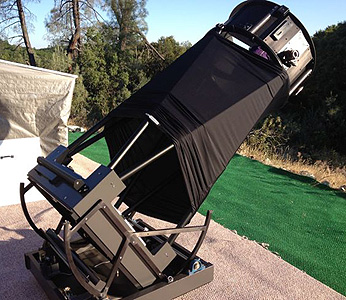 24"
f/3.25 visual Newtonian
24"
f/3.25 visual NewtonianThe optics for this telescope were completed in 2012. Tom Osypowski, of Equatorial Platforms, produced the telescope. Chris, the telescope owner said this:
"Mike Lockwood really hit the ball out of the park with this set of optics, and though I am of course relating a purely subjective experience that is not easily relayed unless actually experienced live, and I am certainly not blind to any bias from the sheen of a new purchase, to see such sharp and high contrast views really brought home what a precisely figured mirror in a well designed Newtonian properly collimated under dark skies can do. The Lockwood mirror, the overall design and engineering of Tom's Spica Eyes structure and slip clutch drive and tracking, the Aurora Precision mirror support system and a host of individual stylistic design touches, all worked together as an integral system and delivered big time."
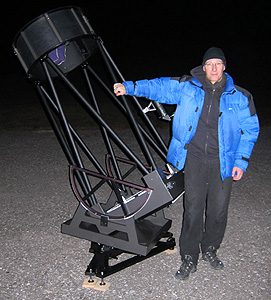 A
second 24" f/3.25 telescope was also built by Equatorial Platforms, and
is now in the hands of a very happy owner, Marc, in Germany. He
sent a photo of first light (at left).
A
second 24" f/3.25 telescope was also built by Equatorial Platforms, and
is now in the hands of a very happy owner, Marc, in Germany. He
sent a photo of first light (at left).In fact, one of his friends was quite impressed, so impressed that he is ordering an even larger 36" f/3.3 optical set for his future telescope.
Marc had some very favorable things to say about the telescope on its first nights out under the stars.
UPADATE - I joined Marc on a cold summer night in August of 2013, high in the Austrian Alps for some observing, the scope performed superbly under some very dark mountain skies. For more about this night, see my article here.
24" f/2.75 research and visual Newtonian
This mirror was completed for an international client who will use it for spectroscopy and possible visual work in the future, so it must be fully up to telescope standards. An extra blank ws purchased, and it turned into the primary for the telescope listed just below.....
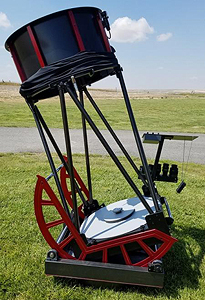 24"
f/2.75 visual Newtonian with transporter, 6.5" m.a. flat
24"
f/2.75 visual Newtonian with transporter, 6.5" m.a. flatThis remarkable telescope was built by a client, Ed, in Montana. It has an array of amazing features, and is a fantastic display of clever engineering and problem solving. It has a battery-powered transporter unit that actually carries the telescope around the field on wheels by remote control This is done after the telescope itself is lifted up by built-in jacks! It has a cooling system that was developed very carefully to evenly cool the mirror, front and back, even when the mirror cover is on (as in the photo) to protect the optics. It has a drive system that automatically disengages clutches whenever the user grabs a handle on the cage, so that it is easily pushed to the next target if that is desired. Also featured is remote collimation, self-leveling, a filter wheel, and a wagon that can be towed behind the telescope! All of this was built by a very skilled engineer owner who is enjoying excellent images from his superb handiwork. See more about this telescope in my Okie-Tex articles linked here: Okie-Tex 2017, Okie-Tex 2018
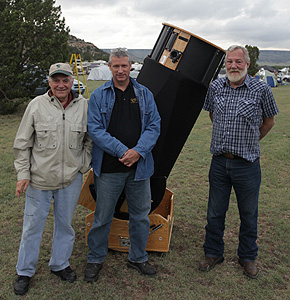 22"
f/3.3 visual Newtonian, 1.4"-thick primary - The FIRST commercial visual f/3.3
telescope
22"
f/3.3 visual Newtonian, 1.4"-thick primary - The FIRST commercial visual f/3.3
telescopeThis mirror was finished in March of 2009, and it has an important claim to fame - it was the FIRST commercially available f/3.3 visual telescope. Others are now making this focal ratio, but Lockwood Custom Optics did it first, and is the most experienced with these fast mirrors. The structure was built by Starmaster Portable Telescopes.
The 20" f/3 telescope shown below provided the visual proof that an f/3 telescope could provide stunning visual images using modern eyepieces and coma correctors, and Rick Singmaster immediately decided to offer a 22" f/3.3 telescope. The Super-FX line was later expanded to include 20", 24", 28", and 30" f/3.3 telescopes, also firsts. Many f/3.3s of various sizes have been produced in recent years. The scope is pictured here with (from left) Al Nagler (TeleVue), John Joseph (Starlight Instruments) and Rick Singmaster (Starmaster Portable Telescopes).
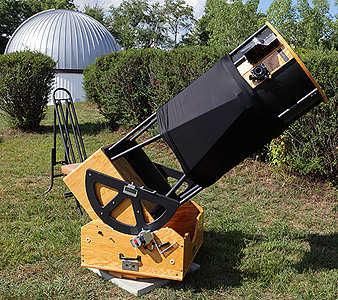 20"
f/3.3 visual Newtonian, 1.25"-thick QUARTZ mirror, 4.5" m.a. quartz
secondary
20"
f/3.3 visual Newtonian, 1.25"-thick QUARTZ mirror, 4.5" m.a. quartz
secondaryI produced the first 20" f/3.3 quartz mirror in May of 2010 for Starmaster Portable Telescopes. This mirror was the thinnest 20" mirror ever offered in a production visual telescope, and the first such scope with all-quartz optics. The thickness and substrate type make it, in LCO's opinion, the best performing 20" Newtonian available, especially while the air temperature is dropping. The thin primary can keep up with temperature drops far better than thicker mirrors, providing much better images during the cooling evening hours. The more stable quartz primary and secondary change also shape less than a Pyrex mirror would as they cool. These telescopes have been extremely well-received by their owners, who often show them to friends who decide that they want one for themselves!
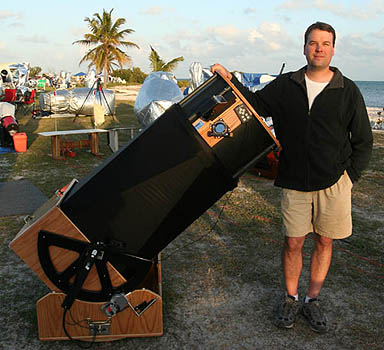 20"
f/3.0 visual Newtonian (1.25"-thick Pyrex primary), 4.5" m.a. secondary
mirror
20"
f/3.0 visual Newtonian (1.25"-thick Pyrex primary), 4.5" m.a. secondary
mirrorThis landmark telescope was built for Mike by Starmaster Portable Telescopes, and was the first commercially built f/3 visual telescope in the world. It proved the concept, and Starmaster began building f/3.3 scopes after this scope was evaluated and found to perform as well as or better than other 20" instruments. Featuring one of the thinnest (1.25"-thick Pyrex) and thus fastest-cooling 20" primary mirrors ever made, it outperformed 20" and larger scopes with slow-cooling, thicker mirrors. Mike Lockwood still uses it for most of his observing, and finds that the "seeing" in the midwest is not as bad as it used to be when he used thicker mirrors.
This telescope was used to test the then-new Paracorr type 2 and Starlight Integrated Paracorr System (SIPS), which I highly recommend for all fast Newtonian visual telescopes. Three articles have been written about this instrument: First look at the Starmaster 20" f/3 MX, Observing with the 20" f/3 in Missouri, The 20" f/3 goes to Florida and WSP 2009, and it has been featured in columns in Astronomy Magazine and Sky and Telescope.
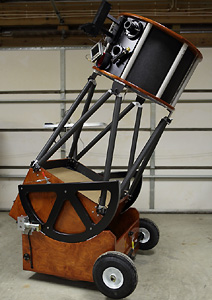 20"
f/3.0 visual/imaging Newtonian (1.25"-thick
Pyrex primary),
5.0" m.a. secondary mirror
20"
f/3.0 visual/imaging Newtonian (1.25"-thick
Pyrex primary),
5.0" m.a. secondary mirrorThis telescope was built by John Pratte of JPAstrocraft.com for a private client in Florda. He will use it for visual and video observing as well as some imaging. The primary is 1.25"-thick Pyrex, just like the mirror in my telescope shown in the section above.
It has many unique features, including multiple sets of truss pole brackets to position the focal plane for visual use, use with a Mallincam, and imaging with a DSLR. It includes a mirror cell made specificially for this thin mirror. The edge support of the cell was tested in the LCO shop with the nearly-spherical mirror, and was found to perform superbly. So, aiming this telescope low at the jewels in the southern sky visible from Florida is encouraged. It also has many other features that will no doubt be discussed on the JPAstrocraft web site at some point. Its owner reports seeing markings on Ganymede during one observing session, so clearly fast telescopes can produce planetary images of the highest quality, and they have added advantages such as image stability on windy nights. This highly-customized instrument clearly has many more amazing observations in its future.
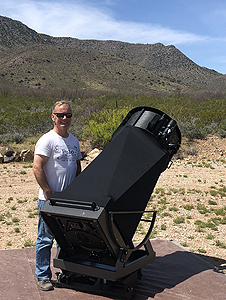 20"
f/3.0 visual Newtonian (1.25"-thick
Pyrex primary), 4.8" m.a. secondary mirror
20"
f/3.0 visual Newtonian (1.25"-thick
Pyrex primary), 4.8" m.a. secondary mirrorThis telescope was built by Tom Osypowski of Equatorial Platforms for a client in Arizona. He takes it to a remote observing site and stays there for a week or more, and that makes Mike Lockwood very jealous!
It is a push-to telescope riding on top of one of Tom's superb equatorial platforms, and features a Starlight Instruments SIPS to simplify observing and provide ideal coma correction no matter the eyepiece.
During a recent 10-day outing, the owner had a great night and said:
"I had that magical night where the transparency and seeing were both near perfect and I could see the mirror operating at maximum performance. I literally ran out of eyepieces to try. I spent hours operating at the highest powers available with no discernable image breakdown. Even at nearly 500x magnification, stars were the tiniest pinpoints and galaxies were mazes of detail with dark lanes and bright knots and H-II regions seemingly everywhere I looked."
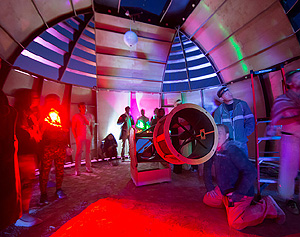 20" f/4.5 visual Newtonian
20" f/4.5 visual NewtonianThese optics were made for an organization that built a telescope and observatory for use at various festivals. It was completed in time to be used at the 2014 Burning Man festival. The photo, taken by Ken Bocchino (link to his photostream), shows the completed telescope in the unique observatory that was built to help shelter it from the surrounding lights and wind. One of the people involved says:
"That 20" has gotten 10 years of use in 3 years. We've taken it to Burning Man in Nevada twice, Bequinox Festival in Joshua Tree 3 times, Lucidity Festival in Santa Barbara, Ca, San Diego 3 times for various events, Joshua Tree National Park, John Adams Middle School, Lightning in a Bottle, Amboy Crater, L.A. Natural History Museum twice and too many more to list here. I'd say at least 150,000 people have looked through our scope. Thanks from all those people who you've helped inspire. We're shooting for a meter next time. :)"
20" f/2.4 quartz parabolic LIDAR mirror
This optic was completed in early 2017 for a scientific client.
20" f/2.0 quartz precision spherical mirror
This optic was completed in 2018 for a scientific client, including full interferometric documentation.
18" f/11 fused silica classical Cassegrain optical set
These optics were refigured in 2014 for a European client.
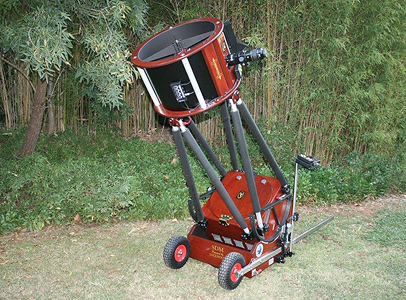 18"
f/4.0 visual Newtonian
18"
f/4.0 visual NewtonianThis beautiful telescope was built down under by Peter Read of SDM Telescopes. As some of his creations do, it is destined to end up in another part of the world. That's how much people appreciate Peter's work and dedication. The mirror was made some time ago, but did not find a home until recently. However, it's now quite happy in this fine structure, and Peter says:
"...it is performing beautifully both optically and mechanically.....lovely pin point stars. Pulled in some faint galaxies and Omega Centauri nearly knocked my socks off."
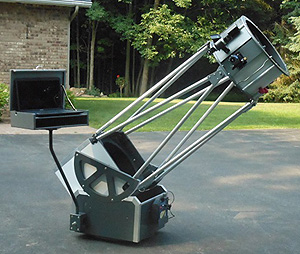 17.5"
f/4.5 visual Newtonian
17.5"
f/4.5 visual NewtonianJim Volhard of Wisconsin built this beautiful telescope himself. I supplied the primary, which started life as a Coulter mirror that I completely re-polished, and secondary mirror. On a cold Wisconsin winter night, Jim saw something remarkable, which he describes in his own words below.
"As I studied the featureless fuzzy blob at 250x I noticed a tiny, thin thread on one side that popped into view several times. Now about half asleep my eye saw the jet but my brain said you cannot see that and I moved on. Not until the next day after some sleep did I recall what I saw and using Steve Gottlieb's NCG Notes as a reference I discovered that I could indeed see the jet in M87..."
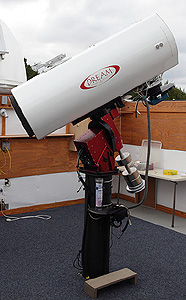 16"
f/3.75 monolithic and cast cellular primaries, 5.75" cast cellular
secondary flat
16"
f/3.75 monolithic and cast cellular primaries, 5.75" cast cellular
secondary flatDream Telescopes began offerering 16" astrographs a number of years ago, and I made a series of monolithic primaries, 1.25" thick. Shane Santi then switched from monolithic to cast cellular blanks, and LCO completed a number of those. (The leftover 16.5" blanks later became the Starmaster 16.5" f/3.65 FX telescope primaries that so many have become fans of, and you can read that story here.)
These carbon-fiber telescopes offer exceptional stiffness, and are incredibly stable in terms of focus and collimation as the telescope is moved to point anywhere in the sky.
LCO has also completed several 24" cast cellular primaries for these instruments and other clients, as well as some 7.75" cast cellular secondary flat mirrors. Despite their superb performance, Dream has brought much of their optical work in-house.
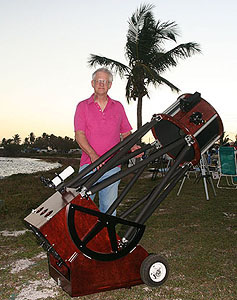 16"
f/4.0
visual
Newtonian
16"
f/4.0
visual
NewtonianA 16" f/4 instrument is one of the most convenient sized telescopes for observing that I have seen. It offers quite a bit of aperture, but the scope parts are easily handled by most people. The eyepiece height is just about ideal for most people, too. It proves very popular at star parties and outreach events because everyone can look through it without having to climb up on a ladder.
John Pratte of JPAstrocraft.com builds fine instruments of high quality, high structural integrity and rigidity, and superb appearance. These instruments usually feature an LCO 16" f/4 primary and secondary tested by LCO.
To fine woodworking and a beautiful wood finish, John also adds exceptional mechanical stability. His mirror cells and truss poles are made of his own designs, for stability and repeatable assembly.
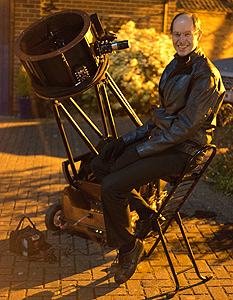 16"
f/4.0
visual
Newtonian
16"
f/4.0
visual
NewtonianThis 16" f/4 was built by JPAstrocraft, and features a Pyrex primary mirror and a LCO-tested 3.5" m.a. flat, a Servocat drive system, JPA-configured cooling fans, and quality JPA construction and features. On its first night out, the client was using it at nearly 500x and enjoying the views when the seeing became steady for a moment. LCO believes that this is how a telescope should behave, and the client looks forward to many more nights of seated, high-quality observing from this instrument. The owner says:
"I simply *had* to put the 3.7mm Ethos in the focuser. With the Paracorr in place this gave a magnification of 497x, which is frankly silly by UK standards..... It was a relatively calm night and there were moments of delightfully rich clarity. Certainly it was very obvious that the scope was capable of handling absolutely all of the magnification the seeing would support."
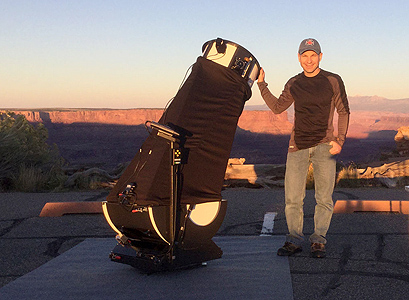 15.75"
f/4.0
visual
Newtonian, quartz primary, 3.5" m.a. quartz secondary
15.75"
f/4.0
visual
Newtonian, quartz primary, 3.5" m.a. quartz secondaryThis 15.75" custom telescope was built by StarStructure Telescopes. The owner is extremely happy with the optics and telescope's very solid mechanics. He says:
"I didn't want to mess around and always wonder if my mirror was OK or if a better scope would be easier to use so I spent about a year researching everything before deciding on gear I would be confident with. I haven't been disappointed... ...When the skies are steady, your mirror puts up a gorgeous view of Jupiter with crisp moon transit shadows."
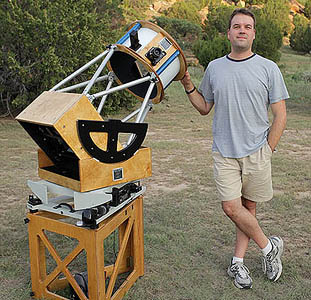 14.5"
f/2.55
visual
Newtonian, 4.5" m.a. sec. mirror
14.5"
f/2.55
visual
Newtonian, 4.5" m.a. sec. mirrorMike Lockwood built this telescope (mirror cell and truss poles were made by JPAstrocraft) as an experimental instrument to see how modern eyepieces and coma correctors would perform in such a fast system. As it turns out, it performs quite well, even on planets, and he hopes to use it in the future as a video astronomy instrument when cold winds or mosquitoes drive him inside on clear nights.
Mike says it is absolutely amazing for scanning the dark and light nebula in the summer Milky Way under a dark sky. While the edge of the field with wide angle eyepieces is not perfect, at high power it performs surprisingly well, showing lots of detail on Jupiter's disk.
Here's a link to an article about this scope at the Okie-Tex Star Party.
 13"
f/5 binocular visual Newtonian telescope
13"
f/5 binocular visual Newtonian telescopeArie Otte of the Netherlands built this beautiful instrument for visual observing. LCO supplied the 1.1"-thick primary mirrors and some elliptical flats.
This type of instrument consists of two complete 13" f/5 Newtonian telescopes, built into one structure. Each upper cage contains two mirrors, one in the center of the tube to reflect the light path out the side like a normal Newtonian, but then another mirror to reflect the light path upward. The eyepieces are located just below and between the upper cages. The cages are rotated to adjust the inter-ocular distance (distance between eyes), and the user looks down toward the primary mirrors into the eyepieces.
This installment of "In the Shop" links to his own web site about it. It's recommended reading.
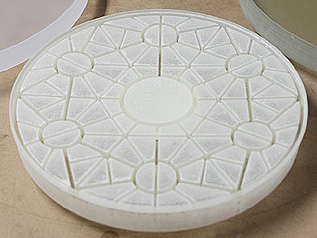 12"
f/4 cast
cellular
primary mirror, weight: 3.5 lbs!
12"
f/4 cast
cellular
primary mirror, weight: 3.5 lbs!This very lightweight primary mirror was made for a private client, and can be seen in this installment of "In the Shop".
It weighs only 3.5 lbs, a fraction of what a conventional 12" solid Pyrex blank at say, 2.25" thick, would weigh.
This miror will likely cool off at least 10x faster than a monolithic blank of similar dimension. Such optics are not cheap, but the payoff in improved cooling is worth it in many applications. LCO made a superb mirror from this somewhat delicate substrate.
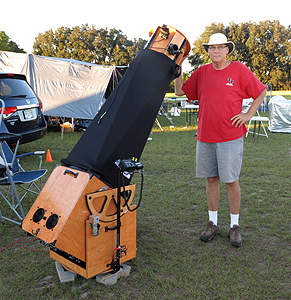 12.5" f/6.5 Newtonian
12.5" f/6.5 NewtonianThis alt-azimuth Newtonian was built by Teeter's Telescopes, and is used by its owner, Dave, for demanding double star work. It is serial number TT#147, and features a custom, moving-frame mirror cell with whiffletree and roller edge supports built by JPAstrocraft.
This telescope has already split sub-arcsecond double stars from Florida, and features a full Servocat drive system to find objects and keep them centered in the field of view. Mike has had the opportunity to observe with it, and gives it a big thumbs up.
The mirror is 1.1"-thick Pyrex, and started life as a 16" blank that was damaged before Mike ended up with it. This beautifully annealed piece of glass was waterjet down to 12.5" and finished up by Mike, and this is why the f/# is a bit unusual.
In 2018, LCO made a run of six 10" f/3.0 mirrors from quartz blanks. These have gone into a variety of telescopes, mostly built by the owner. LCO hopes to write an article about these telescopes in the future, including one that Mike Lockwood intends to build himself, specifically designed for observing with a nightvision monocular.
10" f/2.4 spherical mirror, lightweighted Zerodur substrate
This mirror was made for an aerospace client in mid-2015. It is a very lightweighted Zerodur mirror that was ground and polished, and then measured and final figuring done using a phase-shifting interferometer.
This was a challenging project to polish given the thickness of the material between the ribs, and the possibility of print-through. It is shown at right, supported on a machined central hub for interferometric testing during the polishing work. Metal pucks are already bonded to it to secure it in its future holder. This mirror is used for validating the design of an optical system.
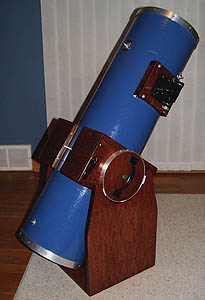 8"
f/3.9 Pyrex
primary
mirror
8"
f/3.9 Pyrex
primary
mirrorThis was the first mirror that Mike Lockwood ever made, so maybe it is a bit easier to understand why he makes fast mirrors. Here's a link to a short web page about it on his ATM page.
It was not easy to make, and started off as a mirror-grinding kit from Willmann-Bell that was ground to several focal ratios before he finally settled upon something around f/4. Dick Wessling gave some advice over the phone regarding figuring, and that started off his journey into mirror making.
Mike says:
"I have enjoyed this telescope observing Mars, and also when used as a wide-field instrument under very dark skies. After completing this very nice mirror, I had the skills and courage to start tackling some mirrors that needed refiguring. Soon afterward I was making new mirrors for friends, and the rest is history."
